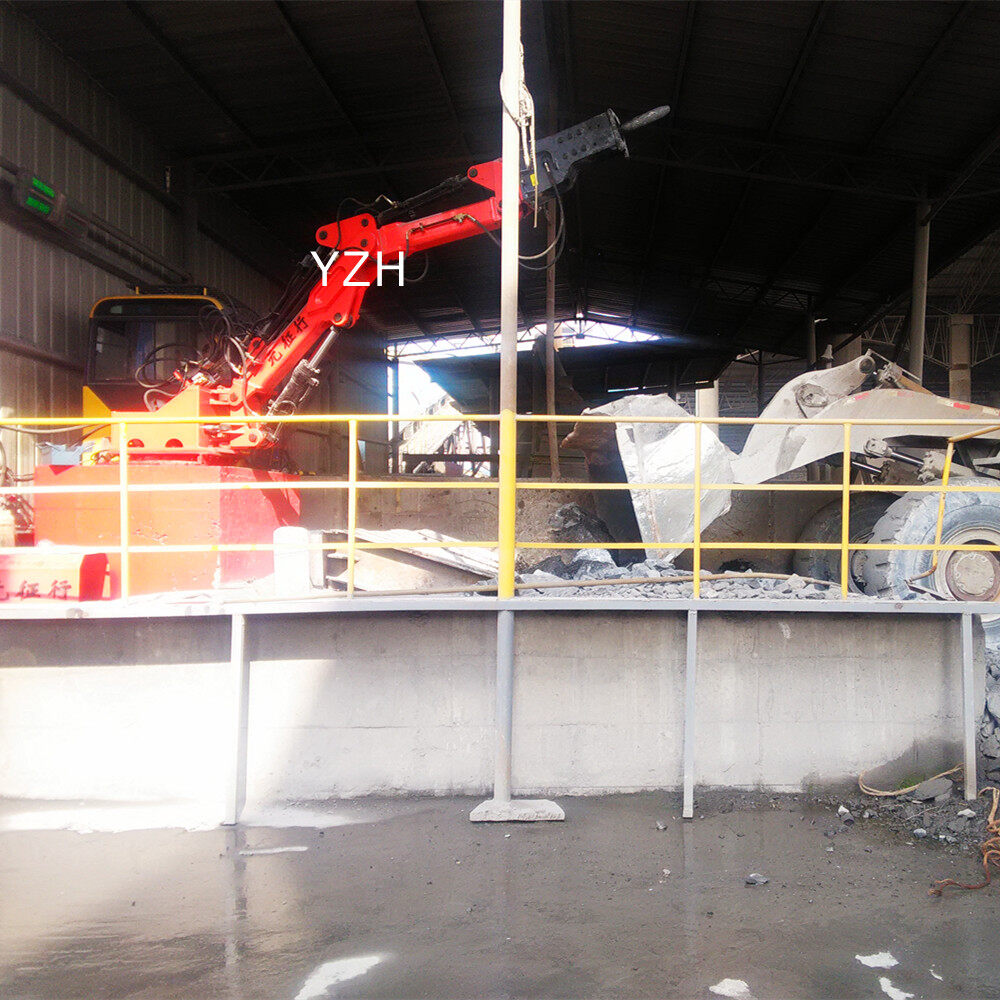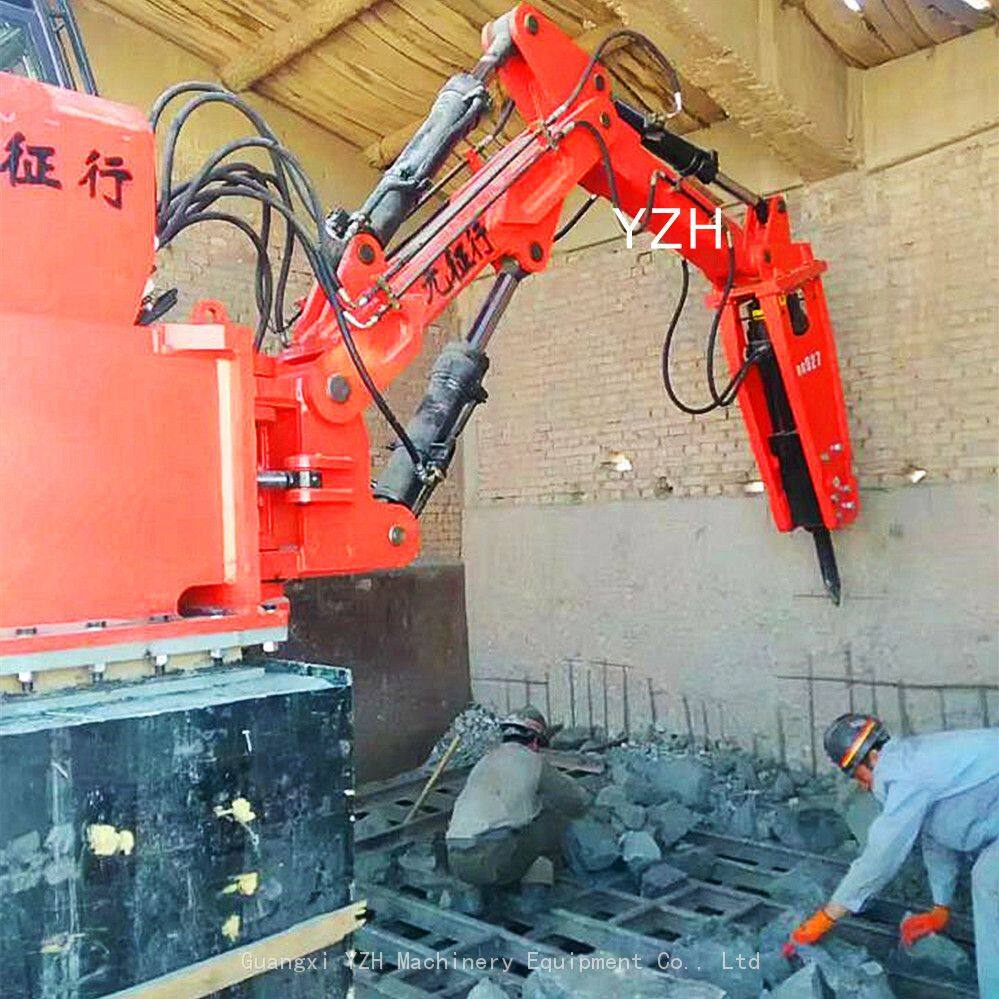Главная > Новости компании > Comprehensive Guide for Selecting Fixed Boom System
-
 Sherry
Добро пожаловать в мой магазин. Я рад вам обслуживать. Не стесняйтесь задавать мне любые вопросы.
Sherry
Добро пожаловать в мой магазин. Я рад вам обслуживать. Не стесняйтесь задавать мне любые вопросы.
Ваше сообщение превысило лимит.
Новости компании

Comprehensive Guide for Selecting Fixed Boom System
Fixed Boom Systems (also known as pedestal boom or rock breaker boom systems) are widely used in mining, ore crushing, and construction waste processing industries. When selecting the appropriate fixed boom system, it is essential to consider multiple factors comprehensively. Below are the key steps and factors to focus on when selecting a fixed boom system.
1. Workplace Selection
When choosing a fixed boom system, the first consideration should be the type of workplace. Different work
environments have different requirements for the fixed boom system, including the following:
Underground Mining (Underground): If the work environment is located in an underground mine, the fixed boom system needs to have strong pressure resistance and the ability to adapt to confined spaces. Additionally, explosion-proof and dust-proof capabilities must be taken into account. Our B-Series fixed boom systems, with their compact size and powerful capabilities, are well-suited for such environments.
Opencast Mining (Opencast): In open-pit mining environments, the fixed boom system needs to be highly adaptable and capable of working in large open areas.
Aggregate Plant: In aggregate production lines, the fixed boom system should have strong crushing capabilities and stability to ensure efficient material handling.
Other Workplaces (Others): This category includes specialized work environments such as waste recycling, earthworks, and more.
2. Rock Type and Hardness
The type and hardness of the rock are crucial factors in determining the suitability of a fixed boom system. Consider the following aspects:
Rock Type and Hardness: Different types of rocks (such as granite, limestone, sandstone) have varying hardness. Harder rocks require more robust crushing tools and higher-power systems.
Maximum Rock Size: The fixed boom system must be capable of handling rocks of different sizes. Larger rocks require larger crushing tools.
Rock Processing Capacity per Hour: This parameter determines the workload of the robotic arm. The selected fixed boom system should be capable of processing the required number of rocks per hour.
3. Type of Crushing Operation
Based on the type of crushing operation, choose the appropriate fixed boom system model and functional configuration:
Crusher, Grizzly Screen, or Others:
If crushing is the primary task, select a fixed boom system equipped with suitable crushing tools.
If screening is the primary task, choose equipment suitable for screening.
Crusher Type and Brand: Select the appropriate type (e.g., jaw crusher, impact crusher) and brand of crusher to ensure compatibility with the fixed boom system. Different crushers require different fixed boom system
Grizzly Size and Mesh Size: If screening is involved, the grizzly size and mesh size should be considered to meet the required screening specifications.
4. Working Requirements
Determining the working requirements is a crucial step in selecting the appropriate fixed boom system. This impacts the adaptability and performance of the equipment:
Rotation Angle: The rotation angle of the fixed boom system determines its work range. A larger rotation angle increases the flexibility of the fixed boom system. Our fixed boom systems address this by offering rotation angles of 170° and 360°, meeting the needs of most environments.
Work Area: Choose a fixed boom system based on the size of the work area to ensure it can cover all the necessary zones.
Working Hours per Day: The fixed boom system should be capable of operating for the required number of hours per day without excessive fatigue or damage.
Maximum and Minimum Temperature at Site: Temperature fluctuations can affect the performance of the fixed boom system. The equipment should be able to withstand extreme temperatures to maintain performance in cold or hot environments.
5. Rock Breaker Boom Systems Selection
When selecting a fixed boom system, the rock breaker boom system is one of the key components:
Hydraulic Breaker Selection:
Tool Type: Common tools include blunt chisel, moil, and cone. Different tools are suitable for different types of rocks.
With or Without Accumulator: Breakers with accumulators can provide a stronger impact force, making them suitable for harder rocks.
6. Foundation Type
The foundation type determines the stability and adaptability of the fixed boom system installation. Common foundation types include:
Concrete Foundation: Suitable for environments that require the ability to withstand significant vibration and pressure.
Steel Structure Foundation: Suitable for more flexible environments where quick installation or dismantling is required.
We will recommend and provide suitable foundations based on the site conditions and customer needs.
7. Control Mode
The control mode is an important factor to consider when selecting a fixed boom system, as it directly affects the ease of operation and safety:
Cabin Control: The operator directly controls the fixed boom system from a cabin, making it suitable for environments with high safety requirements.
5G Teleoperation System: Suitable for situations requiring remote control, enhancing operational flexibility and safety.
Wireless Remote Control: The operator can control the fixed boom system from a distance using wireless devices, suitable for complex or hazardous environments.
8. Hydraulic Power Unit Selection
The hydraulic power unit provides power to the fixed boom system, so selecting the right hydraulic unit is crucial:
Choose an appropriate hydraulic power unit to ensure its output capacity meets the demands of the crushing operation.
9. Location of Hydraulic Power Unit
The location of the hydraulic power unit directly affects the equipment’s spatial footprint and maintenance convenience:
Hydraulic Power Unit Size and Location: Choose the appropriate size to ensure the stability and safety of the equipment. The location should be convenient for maintenance to avoid operational issues caused by poor placement.

Популярные поиски
- Промышленный агитатор
- Буронапорный насос
- дезандер
- смесительные устройства
- зажигательное устройство
- газовое зажигательное устройство
- очиститель грязи
- Буронасосный насос
- Ручной вакуумный насос
- Система для обработки бурового раствора
- циклонный десэндер
- Триплексный шламовой насос
- вакуумный дегазатор
- Гидроциклонный десэндер
- Газосепаратор бурового раствора
- дезилтер

